Welcome to British Columbia Driver License Guide
In this easy British Columbia Driver License Guide, we get into the different driver license Classes in beautiful BC and break down what types of vehicles a driver may drive with each Class of license. For a similar article, check out our guide to the BC Class 7 “N” Restrictions, or What is the Graduated Licensing Program?
Class 5 or 7 driver’s license
Class 5 is the most common driver’s license for regular passenger vehicles in British Columbia. Class 7L is a learner’s permit that allows folks to practice their driving skills to prepare for the first road test. In order to get a Class 7L license, folks must be 16 at least years old and pass a vision screening test with ICBC. Folks will also have to pass a written knowledge test, which includes a road signs test as well.
Once the first road test is passed, folks will be issued a Class 7N (Novice) license. They will need to drive safely for two years, or 18 months with an approved driver education course before attempting the Class 5 Road Test. This is all part of ICBC’s graduated licensing program.
What can I drive with a Class 5 in BC? Class 5 and 7 drivers may drive:
- Cars, vans, trucks, construction, and utility vehicles that have 2 axles maximum
- Motorhomes – can exceed 2 axles
- Tow trailers or vehicles up to 4,600 kg
- Limited-speed motorcycle or an all-terrain vehicle (ATV)
- 3-wheeled vehicles [does not include 3-wheeled motorcycles (trikes) or motorcycle/sidecar combinations]
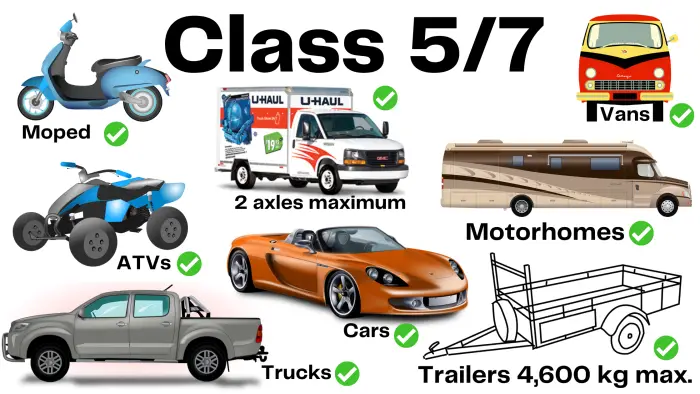
Class 6 or 8 driver’s license
A Class 6 License is required to ride a motorcycle or a scooter that is 51cc or bigger. The Class 8 road test is for learner motorcycle riders who don’t yet have a B.C. driver’s license, or for those riders who are in the “L” or “N” stage of the GLP program for passenger vehicles.
With a Class 6 or 8 BC license, you can drive:
- Motorcycles
- All-terrain cycles
- All-terrain vehicles (ATVs)
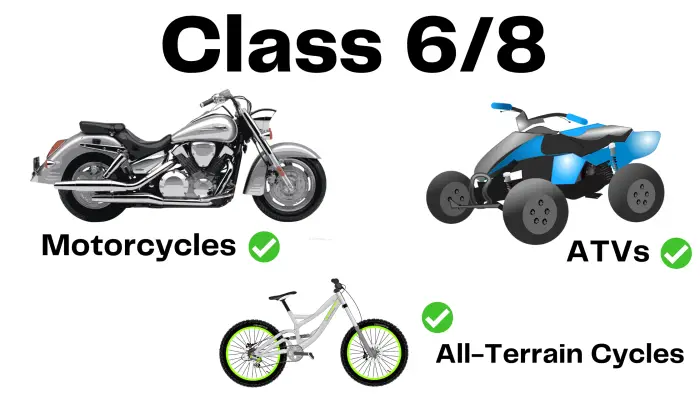
How to get your Class 6 or Class 8 – For BC Drivers Who Have a Class 1-5 Full Privilege License
If you already have a full-privilege B.C. driver’s license (Class 1-5), here’s how to get started with riding.
Step 1: Get your motorcycle learner’s license
- Pass the motorcycle knowledge test.
- Your parent or a legal guardian must give consent for your application if you’re under 19
Step 2: Pass the motorcycle skills test
- After at least 14 days with your learners you can take the motorcycle skills test
- If you take certified motorcycle training and qualify there is no waiting period and the motorcycle skills test is included
Step 3: Get your full motorcycle license
- After at least 30 days of being a learner, you can get your full license by passing the class 6 road test
How to get your Class 6 or Class 8 – For L & N Drivers or new drivers
Drivers with less than two year’s driving experience have some extra steps in getting licensed. It’s ICBC’s way to help reduce crash risks while you’re gaining valuable on-road experience.
Step 1: Get your motorcycle learner’s license
- Pass the motorcycle knowledge test
- If you don’t have your L or N, you’ll also have to pass the passenger-vehicle knowledge test
- Your parent or a legal guardian must give consent for your application if you’re under 19
Step 2: Pass the motorcycle skills test
- After at least 30 days with your L, you can take the motorcycle skills test
Step 3: Pass the Class 8 motorcycle road test
- After passing the motorcycle skills test and having your L for at least 12 months, you can take the Class 8 motorcycle road test
- When you pass the Class 8 road test, you enter the Novice stage
Step 4: Get your full motorcycle license
- After at least 24 months with your N, you can take the final test-the Class 6 motorcycle road test
- If you also have a passenger vehicle 7N license you only need to complete one road test to exit GLP
Class 4 Unrestricted
With a Class 4 Unrestricted BC license, you can drive:
- Buses with a maximum seating capacity of 25 people including the driver
- School buses
- Special activity buses
- Special vehicles used to transport people with disabilities (such as Handy DART)
- Taxis
- Limousines
- Uber, Lyft, or another ride-sharing service
- Ambulances
- Cars, vans, trucks, construction, and utility vehicles that have 2 axles maximum
- Motorhomes – can exceed 2 axles
- Tow trailers or vehicles up to 4,600 kg
- Limited-speed motorcycle or an all-terrain vehicle (ATV)
- 3-wheeled vehicles [does not include 3-wheeled motorcycles (trikes) or motorcycle/sidecar combinations]

Class 4 Restricted
With a Class 4 Restricted BC license, you can drive:
- Taxis and limousines of up to 10 people including the driver
- Uber, Lyft, or another ride-hailing service
- Ambulances
- Special vehicles with a seating capacity of not more than 10 people including the driver used to transport people with disabilities
- Cars, vans, trucks, construction, and utility vehicles that have 2 axles maximum
- Motorhomes – can exceed 2 axles
- Tow trailers or vehicles up to 4,600 kg
- Limited-speed motorcycle or an all-terrain vehicle (ATV)
- 3-wheeled vehicles [does not include 3-wheeled motorcycles (trikes) or motorcycle/sidecar combinations]

Class 3
With a Class 3 BC license, you can drive:
- Trucks with more than two axles, like dump trucks and large tow trucks
- Does not allow driving a bus carrying passengers
- Trailers or towed vehicles exceeding 4,600 kg as long as the truck and trailers do not have air brakes
- A tow car towing a vehicle of any weight
- A mobile truck crane
- Regular cars, vans, trucks, construction, and utility vehicles
- Motorhomes – can exceed 2 axles
- Limited-speed motorcycle or an all-terrain vehicle (ATV)
- 3-wheeled vehicles [does not include 3-wheeled motorcycles (trikes) or motorcycle/sidecar combinations]
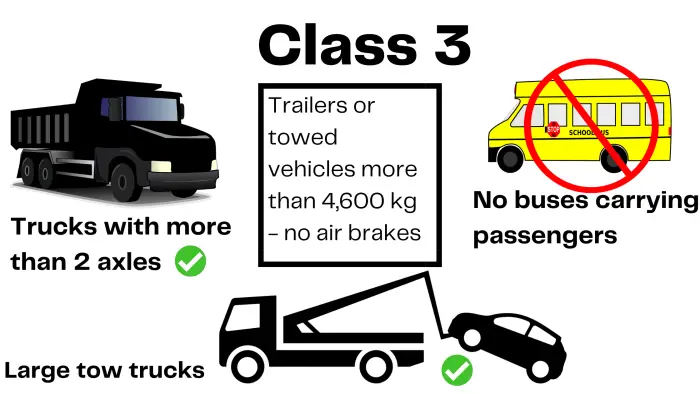
Class 2
With a Class 2 BC license, you can drive:
- Buses, including school buses, special activity buses, and special vehicles
- Buses with a maximum seating capacity of 25 people including the driver, including school buses, special activity buses, and special vehicles used to transport people with disabilities
- Taxis
- Limousines
- Ride-hailing services like Uber or Lyft
- Ambulances
- Cars, vans, trucks, construction, and utility vehicles that have 2 axles maximum
- Motorhomes – can exceed 2 axles
- Tow trailers or vehicles up to 4,600 kg
- Limited-speed motorcycle or an all-terrain vehicle (ATV)
- 3-wheeled vehicles [does not include 3-wheeled motorcycles (trikes) or motorcycle/sidecar combinations]
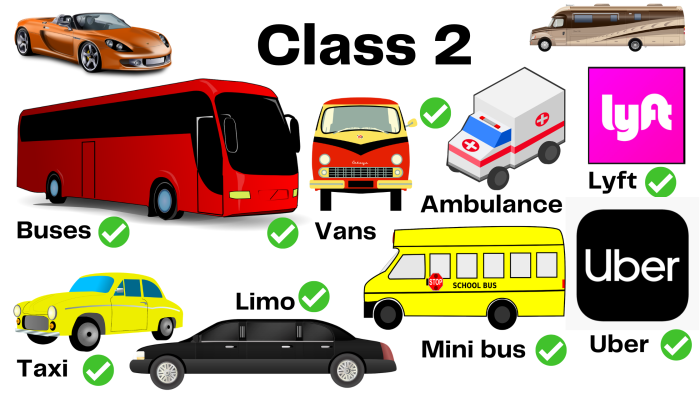
Class 1
With a Class 1 BC license, you can drive:
- Semi-trailer trucks
- All other class 1-5 motor vehicles or combinations of vehicles
- Motorcycles not allowed
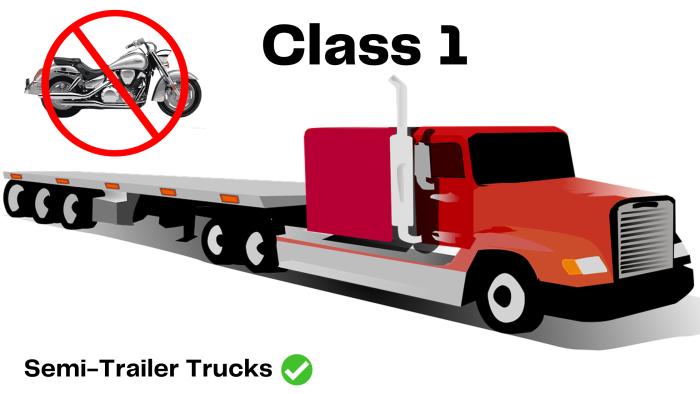
(Code 20) added to Class 4 or 5
With Code 20 added to Class 4 or 5 BC, you can:
- Tow trailers or towed vehicles more than 4,600 kg gross vehicle weight (GVW)
- Neither the vehicle nor the trailer may have air brakes
- With this endorsement, you’ll need to obtain a commercial-class medical assessment
(Code 7) added to Class 4 or 5
With Code 7 added to Class 4 or Class 5 BC, you can:
- Tow a recreational (house) trailer more than 4,600 kg gross vehicle weight (GVW)
- Neither the truck nor the trailer may have air brakes
Mopeds and Scooters
Mopeds and Scooters:
- May be operated with all classes of driver’s licenses except with Class 5 or Class 7 Learner’s Licenses
A limited-speed motorcycle has:
- A motor equipped with a piston displacement of not more than 50 cc
- Or a power source that produces a maximum of 1.5 kW
- A power drive system that does not require clutching or shifting after the drive system is engaged
- A maximum speed of 70 km/h on level ground
- Maximum weight of 95 kg
- Wheels with a diameter of 254 mm or more
Electric bikes
- An electric bike, or motor-assisted cycle (MAC), is a two- or three-wheeled cycle with a seat, pedals, and an electric motor or motor
- Power output not more than 500 watts (in total)
- A motor-assisted cycle (MAC) cannot be gas-powered
- Gas-powered cycles and electric cycles without attached pedals don’t qualify as electric MACs and won’t pass a provincial inspection that would enable them to meet registration, licensing, and insurance requirements for on-road use
- Rider must be 16 or older and wear a bicycle helmet
- Driver’s license and insurance are not required
- You don’t need a driver’s license or need to register, license, and/or insure your MAC
- Riders are subject to the same rights and duties as the driver of a regular car
- Riders also must follow bicycle safety rules
Mopeds
Limited-speed motorcycle definition
- Has a motor equipped with a piston displacement of not more than 50 cc, or a power source that produces a maximum of 1.5 kW
- Does not require clutching or shifting after the drive system is engaged
- Has a maximum speed on level ground of 70 km/h
- Has a maximum weight of 95 kilograms (excluding fuel and batteries)
- Must have wheels with a diameter of 254 mm or more
- Driver’s license required (any class except 5 or 7 learner’s license)
- Riders must wear a helmet
- LSMs must be registered, licensed, and insured for road use
- A motorcycle license is not required
- Riders are also subject to the same rights and duties as the driver of a regular car
Pocket bikes & mini motorcycles
- Mini motor vehicles, commonly known as “pocket bikes” or “mini choppers,” don’t meet federal safety standards for use on public roads
- Their use is limited on public roads to designated parade routes
- If using a mini motor vehicle on a parade route, it must be insured with a minimum $200,000 third-party liability policy
- This coverage is not offered by ICBC
The reason that these vehicles aren’t generally allowed on public roads is:
- They don’t meet minimum height specifications for headlamps, tail lamps, stop lamps, and turn signals
- They’re difficult for other motorists to see
How does Transport Canada classify mini motorcycles? They are restricted-use motorcycles that are allowed to be imported as competition vehicles for closed-course racing only.
Electric kick scooters
- Can only be operated on designated roads in communities participating in BC’s electric kick scooter pilot project
Motorized skateboards
- Cannot be operated on roads in BC
Motorized wheelchairs
- Driver’s license and insurance are not required
- Can be used on sidewalks or roads
- The same rules as pedestrians apply
Related Articles:
- ICBC Road Test Tips Class 5/7 [Instructor Gets Deep]
- Hazard Perception Guide [Road Test Preparations]
- Road Test Fail Tales [Based on True Stories]
Carmen Cohoe
Carmen became a driving instructor in beautiful North Vancouver at the age of 22 due to some crazy people who agreed to hire her. After that, there was never a dull moment teaching many different folks from many different places how to drive using automatic and standard vehicles and a minivan.

